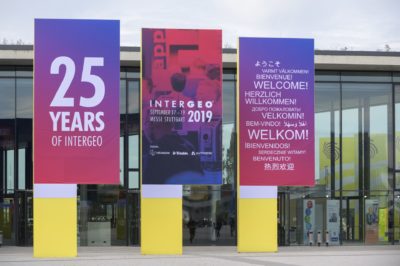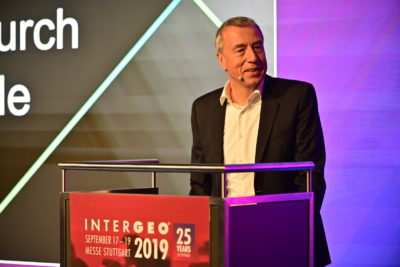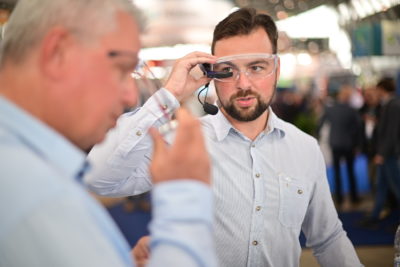After a weekend in rural Switzerland with my old Leica Geosystems colleague Peter Fricker and his family – Peter was involved in sales in Latin America and Switzerland, then in product management on the airborne camera side, so one of the highlights was a game of cards with his daughter on the lens cone of an RC30 that serves as a side table – I returned to Stuttgart for the enormous Intergeo Expo and Conference at the Messe Stuttgart, a huge space for conferences and exhibitions ideally located within walking distance of the airport and S-Bahn station. As the column of participants snaked into the Messe, I wondered how LIDAR Magazine could do justice to an event this size. Denise Wenzel, Head of Communications, HINTE Marketing & Media GmbH, published a release the day after the show closed, “The leading international trade fair for geodesy, geoinformation and land management drew in 18,000 visitors from 42 countries to the exhibition halls in Stuttgart. This year, more than 700 exhibitors showcased their solutions surrounding geodesy, geo-IT, geoinformatics, building information modelling (BIM), drones and smart cities.” We tend to forget too, that there is a conference running alongside the exhibition and that other events are co-located with it, such as the 67th German Cartography Conference and the Frontiers of Geodetic Science symposium. Moreover, this was the 25th Intergeo – a significant milestone – and its motto, “Knowledge and action for planet Earth” could not have been more timely. There was a maturity, a sense of purpose that stood above even the exhuberance of the trade show and its wonderful innovations and incremental developments: speakers were increasingly focusing not on the technology per se, but on its role in addressing the many challenges that threaten our planet’s future and the quality of life of its inhabitants, including climate, environment, energy, mobility and inequality.
Messe, I wondered how LIDAR Magazine could do justice to an event this size. Denise Wenzel, Head of Communications, HINTE Marketing & Media GmbH, published a release the day after the show closed, “The leading international trade fair for geodesy, geoinformation and land management drew in 18,000 visitors from 42 countries to the exhibition halls in Stuttgart. This year, more than 700 exhibitors showcased their solutions surrounding geodesy, geo-IT, geoinformatics, building information modelling (BIM), drones and smart cities.” We tend to forget too, that there is a conference running alongside the exhibition and that other events are co-located with it, such as the 67th German Cartography Conference and the Frontiers of Geodetic Science symposium. Moreover, this was the 25th Intergeo – a significant milestone – and its motto, “Knowledge and action for planet Earth” could not have been more timely. There was a maturity, a sense of purpose that stood above even the exhuberance of the trade show and its wonderful innovations and incremental developments: speakers were increasingly focusing not on the technology per se, but on its role in addressing the many challenges that threaten our planet’s future and the quality of life of its inhabitants, including climate, environment, energy, mobility and inequality.
I attended two strong keynotes on Tuesday morning. The first, from Dr. Michael Frehse, Directorate-General H – Community, Federal Ministry of the Interior, Building and Community, entitled, “Smart homeland – how digitalisation can help achieve equal standards of living”– brought a note of sobriety amongst the razzamatazz as he explained the government’s attempts to reduce inequality across the country, in which some of the Länder (states) are doing better than others. Political action, of course, is never without its detractors, so the Germans are trying hard to seek consensus while addressing the issue with subsidies, improvements to transportation and infrastructure, and other measures. The second keynote was more

President of Hexagon Geosystems, Jürgen Dold
familiar, with the immaculate Jürgen Dold, president of Hexagon’s Geosystems Division, on the podium to address, “Wonderful opportunities through digital business models”. We had seen some of his material before, at the HxGN Live 2019 event in Las Vegas, but this keynote was a little deeper, more conceptual, using Hexagon technologies as exemplars of trends. Between quotes from Arthur C. Clarke, such as, “Any sufficiently advanced technology is indistinguishable from magic”, Jürgen reminded us of the insight of the late professor Wilfried Wester-Ebbinghaus, an eminent close-range photogrammetrist, to the effect that there is much in the world that is wonderful and that a positive approach works best. I was proud that Jürgen found time to mention that Hexagon is celebrating an important anniversary in 2019, 200 years after Jakob Kern set up shop in Aarau, Switzerland, my workplace in the early 1990s.
Publisher Allen Cheves and I made multiple forays on to the show floor, but it would be unfair to highlight only the booths we had time to visit, or to which we had been invited before the show. Suffice it to say that we learned about numerous product launches, including worthwhile improvements to existing systems and sensors. We started work with representatives of several firms on articles that will appear in LIDAR Magazine in the months to come. Some involve companies that we’ve covered before, because we are keen on follow-ups, but others are about firms, often start-ups, which we didn’t know and were serendipitous encounters at Intergeo. So watch these pages for the results.
 On Wednesday afternoon, I attended the big press conference, a rapid fire hour of questions and answers in both English and German. A large panel included several luminaries well known to our readers, including Jürgen Dold (Hexagon), Ron Bisio (Trimble) and Uwe Sörgel (University of Stuttgart). Sadly, I fear the time allotted to each topic was too little for the deeper analysis that this group could have provided. This and many other highlights are on Intergeo TV, restreamed on YouTube.
On Wednesday afternoon, I attended the big press conference, a rapid fire hour of questions and answers in both English and German. A large panel included several luminaries well known to our readers, including Jürgen Dold (Hexagon), Ron Bisio (Trimble) and Uwe Sörgel (University of Stuttgart). Sadly, I fear the time allotted to each topic was too little for the deeper analysis that this group could have provided. This and many other highlights are on Intergeo TV, restreamed on YouTube.
We would have relished further circuits of the five exhibition halls on Thursday, but we had another mission. We had been invited to visit the world-leading Schott glass company at its Mainz location, which is not only the headquarters of the Schott Group, but also the management team of Advanced Optics and other international key departments, including sales for Europe, quality management, marketing, and logistics. Moreover, Mainz is the lead site for glass melting and R&D in optical glass, optical filter glass and the remarkable ZERODUR®. Most of Schott’s many types of glass are developed in Mainz, so it was the obvious place to investigate the cutting edge. Schott plays a leading role in astronomy, not only observatories on earth but also in the air (see below). And now it is embracing automotive lidar: one of our interlocutors was about to leave to participate in Automotive LiDAR 2019 in Detroit, MI! While the Mainz facility dates only from 1952, Schott is much older – in 1884, Otto Schott, Ernst Abbe and Carl and Roderich Zeiss founded the Schott & Associates Glass Technology Laboratory in Jena, Germany. We may say that Schott began, therefore, in the geospatial mainstream and our forthcoming article will in some ways be an update of the record of a much earlier visit to Germany by our editor-in-chief[1].
There ended a memorable few days in Stuttgart. The Intergeo formula not only daunts attendees, but fascinates and ensnares them – they will return to enjoy future iterations of the event and both Berlin in 2020 and Hannover in 2021 will strive to exceed the statistics and successes of Stuttgart in 2019.

SOFIA, the Stratospheric Observatory for Infrared Astronomy, is a Boeing 747SP aircraft modified to carry a 2.7-meter (106-inch) reflecting telescope.
On the way home, however, two chance occurrences kept the geospatial extravaganza alive. On some of the screens in Stuttgart airport, a video clip was playing showing a visit by the Stratospheric Observatory for Infrared Astronomy (SOFIA), a converted Boeing 747 with an opening in the fuselage for scientific observation. SOFIA is an 80/20 joint project of NASA and the German Aerospace Center to construct and maintain an airborne observatory. As I had learned the previous day, Schott was involved. Lastly, as I passed through Munich airport, I bumped into John Welter, division president of Hexagon’s Geospatial Content Solutions. He was anxious to remind me that work is continuing on the article about spaceborne lidar that I have been trying to solicit!
[1] Cheves, M., 1997. Carl Zeiss: 150 years of quality, Professional Surveyor Magazine, 17(6): September.